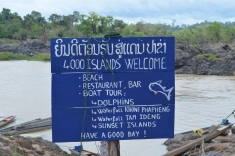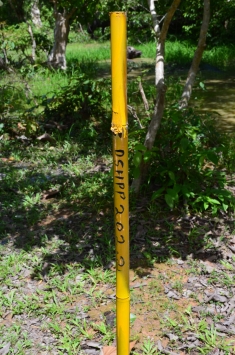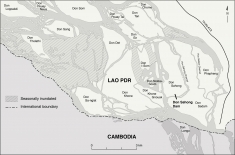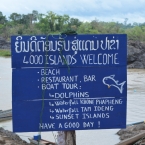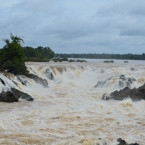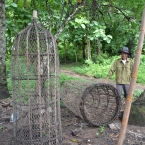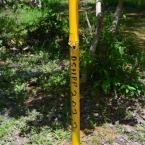Progress on Don Sahong Dam Sets Off a Time Bomb for Mekong Fish
Will Laos circumvent the Mekong River Commission and evade scientific scrutiny?
Idyllic islands. Jumping fish. Breath-taking waterfalls. A sense of calmness and tranquility passes over anyone who is fortunate enough to visit Laos’ 4,000 islands (also known as the Siphandone or the Khone Falls area). The Telegraph’s Sasha Bates recently wrote, “Here, in a relatively small area of southern Laos I feel I've found a microcosm of the rest of the continent.”
Yet, troubled days lie ahead for one of the Mekong River’s most important stretches.
Nestled between the area’s islands and waterfalls, a Malaysian dam company called Mega First is quietly beginning work towards the construction of the 256 MW Don Sahong Dam, a project slated to be the second mainstream dam on the Lower Mekong River. Located just two kilometers from the Lao-Cambodian border, the Don Sahong Dam would block the Hou Sahong Channel, the only channel of the Mekong that allows for year-round fish migrations both up and down the river. While it may not seem as damaging as a dam that is stretched across the entire Mekong, this very channel is key in maintaining the Mekong’s rich fish resources and biodiversity.
While visiting the site of the Don Sahong Dam last month, I was alarmed at the progress that was being made on the project. We discovered that two nearby channels have already been altered in attempts to improve fish passage. The island of Don Sadam was being prepared to make way for the project’s access roads, along with a bridge to the mainland. Villagers reported to us that company officials said construction would start next year. Despite seeing the company workers come on a regular basis over the past few months and even hiring some villagers to assist in site preparations, most affected people have been left in the dark regarding their future. People are unclear about who will be relocated to make way for the project, when they must move, and whether they will be compensated for their lost access to the Mekong’s fisheries.
Despite the work underway, millions of people within the region have not yet been informed—much less consulted—about the Don Sahong Dam. The dam has not yet entered the Mekong River Commission’s (MRC) prior consultation process, as stipulated by the 1995 Mekong Agreement. Instead, the project is a time bomb waiting for detonation. Will Laos circumvent its commitments to consult in good faith with the MRC, as it did with the Xayaburi Dam? Will the MRC remain silent while regional cooperation crumbles?
Why You Should Be Worried About the Don Sahong Dam
The Don Sahong Dam has long been contentious. Fishery experts have already warned of the impending disaster that the dam may bring to the region’s fisheries by blocking the most important channel of the 4,000 islands stretch of the Mekong River. Additional concerns have been raised as the project is expected to blast and remove approximately 95,000 truckloads of river bed from the upstream entrance of the Hou Sahong channel, creating significant ecological impact to the Mekong’s fisheries. In a 1994 study, the Mekong Secretariat called the 4,000 islands “an ecologically unique area” and stated that “such a site is so rare in nature that every effort should be made to preserve all of Khone Falls from any development.” In 2007, 34 scientists sent a letter from the University of Sydney to the Lao government calling upon them “to consider the weight of scientific evidence that will show the Don Sahong project to be hugely destructive, such that even the economic (including livelihood) costs outweigh the net benefits-even before environmental impacts are taken into consideration.”
In response to concerns about the Don Sahong Dam’s impacts on fisheries, Mega First has started to physically alter the channels adjacent to the Hou Sahong, in attempts to get fish to migrate there instead. Yet creating a fish passage is more complicated than it seems. In its 2007 Review Report of the Don Sahong Dam’s Environmental Impact Assessment (EIA) report carried out for the Lao government, the MRC Secretariat warned that the channel modification “(which, it appears, have not previously been undertaken on this scale anywhere in the world) need to be thoroughly investigated and shown to be effective prior to the dam being built.” The Secretariat also raised concerns “that the outflow from the dam would act as a fish attractant for upstream migration, so minimizing the numbers of fish finding passage through other channels.” Lastly, the Secretariat noted that the project’s reports had focused exclusively on upstream migrations and failed to even recognize the importance of downstream migrations.
Why Prior Consultation is Required for the Don Sahong Dam
There is no denying that the Xayaburi Dam and its prior consultation process at the MRC has failed to set a good precedent for regional decision-making. The process remains full of ambiguities, and the MRC governments continue to disagree over its interpretation. International Rivers, neighboring countries, and others criticized the Lao government for violating the 1995 Mekong Agreement when it decided to proceed with the Xayaburi Dam without first making a good faith effort to cooperate with neighboring countries.
With the Don Sahong Dam, the Lao government appears set to circumvent the MRC prior consultation process altogether. Rather than consult with other governments through the MRC, Laos has reportedly been attempting to make bilateral deals with the downstream governments of Cambodia and Vietnam in a push for the project’s approval.
In October 2012, the Lao Vice Minister of Energy and Mines said the project would not undergo prior consultation. He argued that that the Don Sahong Dam is not a mainstream project because it will not stretch across the entire width of the river. Interestingly, in a recent article published in the Vientiane Times on July 1st, there is no mention that the Don Sahong Dam is even on the Mekong River; instead they refer only to the Hou Sahong Channel. The Lao government’s argument is incorrect and without any basis in the 1995 Mekong Agreement or international law. Under Article 5.1 of the 1995 Mekong Agreements’ Procedures for Notification, Prior Consultation and Agreement, prior consultation is required for all intra-basin projects on the mainstream that use dry-season flows.
The MRC Secretariat has already made it clear that the Don Sahong Dam is required to undergo the prior consultation process. In its 2007 Review Report of the Don Sahong Dam’s EIA, the MRC Secretariat concludes that:
“In the event that the project is found feasible and desirable, consideration will have to be made of what mechanism will be used to notify the other Member States visa the MRCS and JC. Information contained in the EIA Report suggests that the DSHEP [Don Sahong Dam] is located on the Mekong mainstream since the source of water for the DSHEP is not from an inflow to the Mekong (hence not a tributary) but rather from upstream mainstream passing through an interconnected system of braided channels created by the vast number of islands at the fault line of the Khone Falls. It is also proposed that power generation would take place throughout the year. The mechanism described in the MA95 [1995 Mekong Agreement] and PNPCA for such a project is the “prior consultation.”
Repeating the Dirty Politics of the Xayaburi Dam
Trying to circumvent the MRC prior consultation is not the only strategy that Laos is pursuing. Laos is already replicating many of the tricks it used to push forward the Xayaburi Dam. Just as the Xayaburi Dam’s construction began two years before it was officially announced, an article in the Vientiane Times on July 1st indicates that Laos is once again trying to distinguish between preparatory work vs. “civil engineering construction.” International law prohibits all forms of project implementation, whether it is labeled as preparatory work or otherwise, until after the prior consultation process concludes.
Additionally, Laos appears to be signing backdoor deals that financially prevent the project from being delayed. While there was a lot of speculation as to which neighboring country would purchase the Don Sahong Dam’s power, a June 14th Daily Report by BCEL-KT Securities Company Limited stated that the Don Sahong Dam will be one of the first dams in Laos to supply its electricity to the Electricite du Laos for domestic consumption. A power purchase agreement appears to have already been signed. This agreement likely binds the Lao government and Mega First to a strict timeline regardless of what happens during any MRC consultations.
The Xayaburi Dam continues to be criticized for not being as environmentally and socially responsible as the developers portray it to be. Perhaps to prevent experts from scrutinizing the Don Sahong Dam too closely, the Lao government has not made the project’s final EIA report public, raising questions about what it is hiding. One wonders what motivates Lao government officials to put so much at risk for such a small amount of energy, especially when a less destructive hydropower alternative has been identified.
The 172 MW Thakho Project has already been proposed on a nearby channel. WWF has promoted this project as the more sustainable alternative to the Don Sahong Dam, stating that “This project has no dam or reservoir and therefore does not sever ecosystem connectivity, allowing for sediment to flow downstream and fish to migrate. Its integrated design also allows for sustainable tourism development.”
Shared Rivers Require Multilateral Dialogue
The Don Sahong Dam, if it proceeds as planned, will condemn the Mekong River and its fisheries to unimaginable disaster producing huge environmental, social and economic costs that simply should not be considered. Rather than allowing one nation to risk the ecological integrity of the entire Mekong for only 256 MW of electricity, it’s clear that the MRC needs to act now.
First and foremost, Laos should adhere to its international responsibilities by halting all work towards the Don Sahong Dam, including efforts to sign its concession, financing and power purchase agreements. Secondly, in order to ensure that upstream and downstream water-users are meaningfully involved in the decision-making process, the MRC’s prior consultation process must be reviewed and its ambiguities resolved before beginning deliberations over future Mekong projects, including the Don Sahong Dam. Third, the Lao government and project developer should release the project’s 2012 EIA report to the public. Rather than hide behind walls of secrecy and unproven claims, Laos should open up the project to public scrutiny in order to ensure informed decision-making based on sound science occurs. Finally, rather than making risky trade-offs between fish and energy, it’s clear that a comprehensive energy options assessment that evaluates the costs and benefits of these projects in the larger context of the Mekong River Basin and the needs of its people is a necessity.

